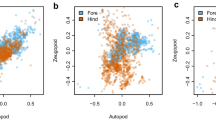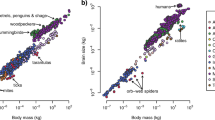Abstract
THE relationship between abundance and body size is the subject of considerable debate in ecology1–15. Several data sets spanning a large range of body sizes show linear negative relationships between abundance and weight l–6 when these are measured on a logarithmic scale. But other studies of the abundances of species from single taxa, such as birds, which span a narrower range of body sizes reveal either little or no relationship, or a triangular relationship 9–15. Errors in estimating abundance might obscure relationships that do exist over a narrow range of body sizes. We describe here the relationship between body weight and abundance in British birds, whose population size estimates are unusually good. Abundance across all species declines with a −0.75 power of body weight, which conforms with the energetic equivalence 'rule'2,16. There is, however, a significant positive relationship between abundance and body weight within lower taxa. Those tribes that do not share recent common ancestry with other British birds are most likely to show a positive relationship across their constituent species. We thus show that phylogenetic relatedness might be an important indicator of the structure of the relationship between body size and abundance.
This is a preview of subscription content, access via your institution
Access options
Subscribe to this journal
Receive 51 print issues and online access
$199.00 per year
only $3.90 per issue
Buy this article
- Purchase on Springer Link
- Instant access to full article PDF
Prices may be subject to local taxes which are calculated during checkout
Similar content being viewed by others
References
Damuth, J. Nature 290, 699–700 (1981).
Damuth, J. Biol. J. Linn. Soc., Lond. 31, 192–246 (1987).
Peters, R. H. The Ecological Implications of Body Size (Cambridge University Press, 1983).
Peters, R. G. & Wassenberg, K. Oecologia 60, 89–90 (1983).
Peters, R. H. & Raelson, J. V. Am. Nat. 124, 498–517 (1984).
Clutton-Brock, T. H. & Harvey, P. H. J. Zool. 183, 1–39 (1977).
Harvey, P. H. & Godfray, H. C. J. Am. Nat. 129, 318–320 (1986).
Sugihara, G. Am. Nat. 133, 458–463 (1989).
Brown, J. H. & Maurer, B. A. Nature 324, 248–250 (1986).
Juanes, F. Am. Nat. 128, 921–929 (1986).
Gaston, K. J. Oikos 53, 49–57 (1988).
Brown, J. H. & Maurer, B. A. Am. Nat. 130, 1–17 (1986).
Gaston, K. J. & Lawton, J. H. Nature 331, 709–712 (1988).
Morse, D. R., Stork, N. E. & Lawton, J. H. Ecol. Entomol. 13, 25–37 (1988).
Blackburn, T. M., Harvey, P. H. & Pagel, M. D. J. Anim. Ecol. 59, 335–345 (1990).
Odum, E. P. Fundamentals of Ecology 3rd edn (Saunders, Philadelphia, 1971).
Marchant, J. H., Hudson, R., Carter, S. P. & Whittington, P. Population Trends in British Breeding Birds (British Trust for Ornithology, Tring, Herts, UK, 1990).
Fisher, J. South Eastern Naturalist and Antiquary 5, 1–10 (1952).
Sharrock, J. T. R. The Atlas of Breeding Birds in Britain and Ireland (British Trust for Ornithology, Tring, Herts, UK, 1990).
Brough, T. Average Weights of Birds (Ministry of Agriculture Fisheries and Food, Worplesdon Laboratory, Surrey, 1983).
Cramp, S. & Simmons, K. E. L. The Birds of the Western Palaearctic Vols 1–5 (Oxford University Press, 1977–1988).
Sibley, C. G., Ahlquist, J. E. & Munroe, B. L. Auk 105, 409–423 (1988).
Howard, R. A. & Moore, A. A Complete Checklist of Birds of the World (Macmillan, London, 1984).
Harvey, P. H., Clutton-Brock, T. H. & Mace, G. M. Proc. natn. Acad. Sci. U.S.A. 77, 4387–4394 (1980).
Harvey, P. H. & Pagel, M. D. The Comparative Method in Evolutionary Biology (Oxford University Press, 1991).
Read, A. F. & Harvey, P. H. J. Zool. 219, 329–353 (1989).
Williamson, M. in Biological Invasions: A Global Perspective (eds Drake, J. A. et al.) 329–350 (Wiley, New York, 1989).
Kleiber, M. The Fire of Life 2nd edn (Kreiger, New York, 1975).
Ulfstrand, S. & Hogstedt, G. Anser 15, 1–32 (1976).
Perrins, C. Birds of Britain and Europe (Collins, London, 1987).
Author information
Authors and Affiliations
Rights and permissions
About this article
Cite this article
Nee, S., Read, A., Greenwood, J. et al. The relationship between abundance and body size in British birds. Nature 351, 312–313 (1991). https://doi.org/10.1038/351312a0
Received:
Accepted:
Issue Date:
DOI: https://doi.org/10.1038/351312a0
This article is cited by
-
Birds’ ecological characteristics differ among habitats: an analysis based on national citizen science data
Community Ecology (2022)
-
Correlates of extinction risk in Chinese endemic birds
Avian Research (2019)
-
Body size and ecological traits in fleas parasitic on small mammals in the Palearctic: larger species attain higher abundance
Oecologia (2018)
-
Size–Density Relationships: a Cross-Community Approach to Benthic Macroinvertebrates in Mediterranean and Black Sea Lagoons
Estuaries and Coasts (2017)
-
Intraspecific scaling in frog calls: the interplay of temperature, body size and metabolic condition
Oecologia (2016)
Comments
By submitting a comment you agree to abide by our Terms and Community Guidelines. If you find something abusive or that does not comply with our terms or guidelines please flag it as inappropriate.



